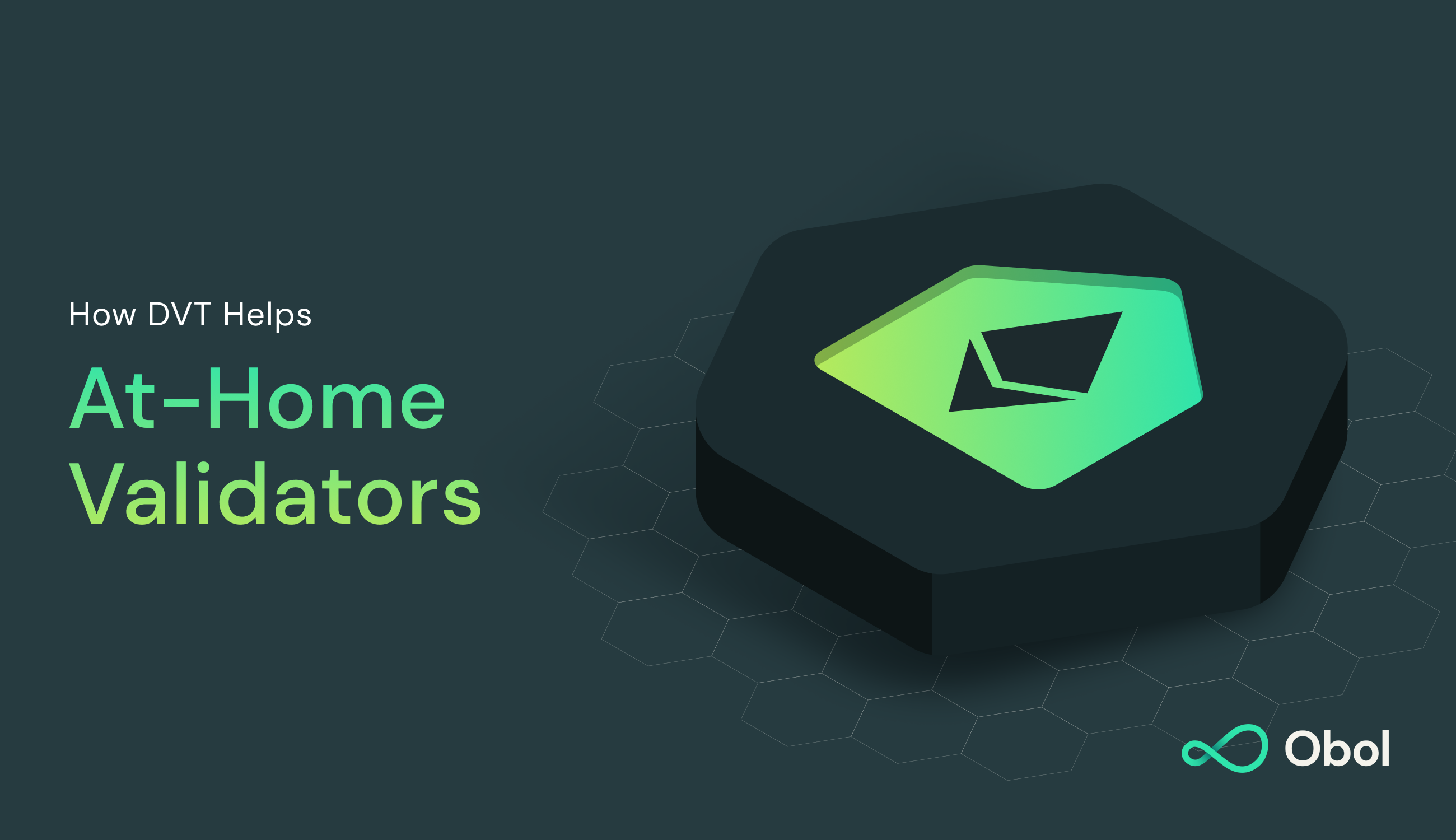How DVT Helps: At-Home Validators
This is part 2 of a multi-part series that explores how DVs help the different types of validators in the Ethereum ecosystem. In this article, we visit arguably the most important type of validator to the Ethereum ethos: at-home validators.

At-home validators, or solo stakers, are the heartbeat of the Ethereum ecosystem. These are the thousands of individuals and small teams that are running Ethereum nodes from their homes & small offices all around the world. They are the driving force behind the decentralisation ethos of the network.

With that said, the participation rate of at-home validators today is still arguably too low. Earlier this year, Rated classified ~6.5% of validators on the Beacon Chain as solo stakers. If, as the EF says, “Solo staking is the best staking option for securing Ethereum,” then why isn’t this percentage higher?
Why it ain’t easy to run an at-home node today
Running a node, as it stands today, isn’t for the faint of heart. There are numerous requirements, considerations, and risks that the at-home validator must be aware of in order to run a node. (It is important to note that we assume simply running a node that is active some, or even most, of the time isn’t enough. What we want to see are at-home validators running highly effective nodes with uptime in the high-90s% that can compare with professional node operators.)
Technical Expertise
While you don’t need to know how to write Solidity to run a node, you do need entry-level DevOps experience to maintain an active node, especially to troubleshoot the inevitable issue that arises.
Hardware Costs
According to the Ethereum Foundation, the minimum hardware requirements for running an at-home node are 4-8GB of RAM and 2TB SSD. However, assuming that the goal is to run a highly effective node, the hardware requirements in effect can be much higher. These beefy machines can easily cost thousands of Euros.
Maintenance Overhead
On top of needing to have the technical know-how to troubleshoot issues, the constant time and attention needed to maintain a node is a commitment that any solo-staker must take on.
Financial Risk
While staking on an at-home node is likely the safest way to stake ETH, it does come with financial risk. The opportunity cost to deploy this ETH in other means (i.e. in an LSP, w/ a staking-as-a-service provider, etc.) can be high, especially if the node you’re running misses out on potential rewards by missing block proposals or attestations.
Bonding Requirement
Even if you’re able to satisfy all the other requirements, one of the biggest barriers of all is sourcing the necessary 32ETH to activate a node. For many, this requires potentially asking your friends (or other sources) to trust you with running that ETH, and if you don’t have the necessary credentials or experience, being able to obtain that amount of ETH is unlikely.
How DVs help lower the barriers for at-home validators
As you probably know by now, distributed validator technology (DVT) allows a single Ethereum validator to be run across multiple machines, creating an active-active redundancy that improves resiliency, security, and decentralisation. The core technology has broad applicability in the staking ecosystem from LSPs to digital asset custodians, and even to Cosmos and decentralising sequencers in L2s. DVs are quickly becoming the security standard for running validators in Ethereum.
For at-home validators, DVT now allows solo stakers to group together with other individuals to validate as a cluster. This has numerous advantages that reduce the barriers for running a highly effective validator from homes and small offices.
Reduces risk associated with trusting at-home validators with stake
In a DV cluster, no single node operator has access to the full validator private key. Rather, each node in a cluster only has a single private key share that must be combined with other key shares in order to generate the full private key. In this setup, an individual or entity looking to stake with at-home validators has much less risk since no individual in the cluster has the power to be able to go rogue or run away with the ETH, and that fact opens up many opportunities for at-home validators to participate without themselves needing the full 32ETH to activate a node.
Since we announced Operation Solo Staker, 450+ applicants from more than 75 countries applied to be part of the program 🤯https://t.co/MKa2OVjGCi
— ether.fi (@ether_fi) June 26, 2023
Big S/O to our partners at @ObolNetwork @DAppNode and @AvadoCloud who helped make Operation Solo Staker a reality! 🏆 🚀
Earlier this year, we worked together with ether.fi to launch Operation Solo Staker. This was an initiative to promote more decentralisation in node operations by sponsoring machines for at-home validators, which can then be slowly paid back from block rewards. Each operator could only participate if they were willing to work together with three other operators in a DV cluster. This added resiliency and uptime benefits. However, most importantly it allowed ether.fi to safely provide the ETH to be staked on these clusters without fear that any one validator would run away with the staked ETH. Without DVT, this would not be possible.
Improves the uptime & effectiveness of (dedicated) at-home validators
In May, the Beacon Chain temporarily stopped finalising. This issue was caused by a high load that subsequently impacted some of the consensus clients on the network. At the same time, we had onboarded our first set of mainnet DV clusters in our Alpha Phase. What we saw was that none of the mainnet DVs were impacted by this outage due to the fact that the clusters were running a range of different consensus clients in each node, which created fault tolerance in the cluster.
The fault tolerance inherent in DV clusters allows at-home validators to drastically improve the effectiveness of their nodes. In testing and in our early mainnet DVs, we found that DVs, run by diligent solo operators, allows nodes being run from homes and small offices to perform with comparable metrics as ones operated by professional validators. This drastically reduces some of the opportunity cost associated with solo staking, since you can now reduce the amount of missed rewards associated with less effective nodes.
Lowers the maintenance overhead of running an at-home validator
The fault tolerance provided by DV clusters also gives at-home validators another benefit; if your machine goes down, it doesn’t mean you need to fix it immediately or lose out on rewards. Your other cluster mates can keep the validator up while you fix your node. For many seasoned node operators, they understand how big of a burden this takes off their shoulders. You get that peace of mind to know that you don’t need to wake up in the middle of the night to fix your node if it goes down; you can #stakeandsleep.
One key consideration: coordination
With all this said, there is one key consideration today to running DVs as a solo-staker: coordination. Obol V1 does not solve the lazy validator problem within a cluster, so operators still must trust the other operators in their cluster. If one member of the cluster isn’t holding up their end of the bargain there isn’t much yet that other members can do to punish the weak member.
This design strategy was chosen to prioritise building a DV middleware that could be highly-effective, anti-correlated, and support the needs of existing validators. Dealing with validator coordination within the protocol, while still keeping all those other requirements intact, is an extremely complicated thing to do (Trustless validators is something we are researching for Obol V2).
There are, however, some mitigating factors. The damage any one operator can do to a cluster is limited by fault tolerance, and soon, we will introduce the ability to edit clusters, which allows operators to be replaced within a cluster. Furthermore, for some, the need to coordinate with fellow operators within a cluster can be seen as a benefit. There is a certain camaraderie that develops within a cluster group, as stronger, more technically-adept validators will naturally step in and help other operators when issues arise. This allows less experienced operators to learn quickly from their peers and develop their own skill sets for the future.
What does the future hold?
The need for more solo staker participation is recognized by many. Recently, the EF launched the Run a Node Grant to promote innovative deployment of Ethereum nodes. While DVs can help lower the barriers for many aspects of running an at-home validator, it doesn’t solve for everything. There still needs to be more guides, how-to videos, and training to help new operators onboard. More general education needs to be provided to make running nodes at-home less daunting for the general staking public.
The good news is that many in the Ethereum community are working on just these types of initiatives. One great example of this is DVStakers, a set of guides written by contributors to the EthStaker Knowledge Base. DVStakers aims to help solo stakers prepare and set up DVs on mainnet. There are already many examples of individuals who have followed this set of guides to successfully deploy DVs for the first time.
So our message to you is this: if you have any ambition at all to run your own node, do it. There are plenty of resources available to help you on this journey, and if you do, make it easier by working with friends to validate using a DV cluster. A great place to start would be to check out our DV Launchpad on Goerli to try your hand at setting up a DV cluster.
